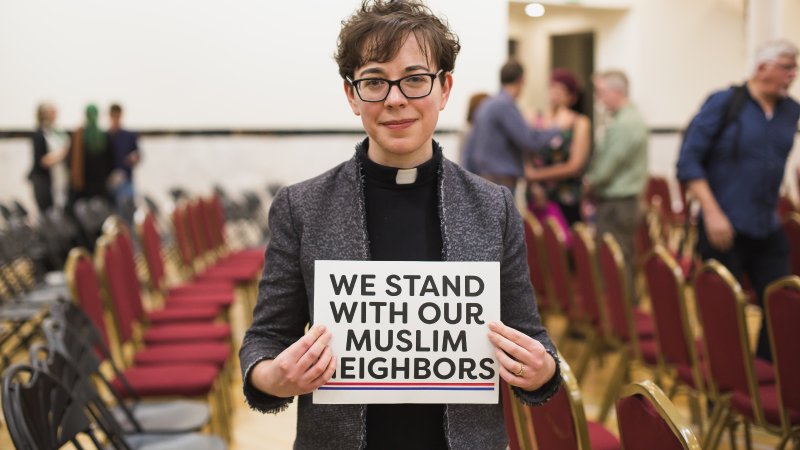
-
HOME
-
WHAT IS STANDOur Mission Our Values Our Help Contact
-
WHAT WE FIGHT FORReligious Freedom Religious Literacy Equality & Human Rights Inclusion & Respect Free Speech Responsible Journalism Corporate Accountability
-
RESOURCESExpert Studies Landmark Decisions White Papers FAQs David Miscavige Religious Freedom Resource Center Freedom of Religion & Human Rights Topic Index Priest-Penitent Privilege Islamophobia
-
HATE MONITORBiased Media Propagandists Hatemongers False Experts Hate Monitor Blog
-
NEWSROOMNews Media Watch Videos Blog
-
TAKE ACTIONCombat Hate & Discrimination Champion Freedom of Religion Demand Accountability
Media Ethics: Read It and Weep
“And they can start by losing those scarves!”
That was the line that pushed me over the edge. I was in the car, driving home after a long day. The radio was tuned to the local NPR station. A woman from Michigan was being interviewed. Let’s call her Mrs. McGillicuddy. She started this way:
“Muslims aren’t welcome here. They’re a threat. They make me uncomfortable. They should all go back to where they came from.” And then the line about the scarves.
Here was a person who was so clueless that she didn’t even realize she was advertising how clueless she was.
OK, Mrs. McGillicuddy. I have a few things to say.

First of all, those “scarves” are called hijabs. They are worn as part of the Islamic tradition of modesty, as instructed in the Quran. They don’t constitute a threat. (Nor does any other Islamic cultural practice.)
Second, the fact that you’re uncomfortable has far more to do with you than anything that Muslim couple walking down the street is doing—because they’re not doing anything to you at all. They are shopping. They are contributing to the economy of your community.
And finally, it wasn’t too many generations ago that your Irish ancestors were the target of similar stereotypical diatribe from people you would have called clueless: “The Irish are a bunch of drunks, blah blah blah.”
Glad I got that off my chest.
But what really got to me was: Given the sorry state of education in this country and her apparent lack of true intellectual curiosity, I can understand her ignorance—she just doesn’t know—but how did she get these inflamed ideas about Muslims?
Left, Right, or Center, the editorial boards all have an agenda. They’re all preaching to their own choir, which also happens to be their financial base.
I could give a toss-off answer and say: “the media.” But that would be the same kind of cheap generality that many of “the media” are guilty of. So let’s be more specific about the role in society of “the media.”
The media—the means by which news and entertainment is communicated or expressed—can be divided into two categories: mainstream media and social media.
Mainstream media is all the newspapers, TV networks, radio networks, and Internet news sites, no matter where they are on the political spectrum. This includes for-profit companies and nonprofit public media. Some may disagree, but for the sake of this discussion I’m including so-called “alternative” media in this category because they are organizations that consider themselves to be services and they need to make a buck.
Now, here’s the thing about mainstream media. Every mainstream media outlet has a viewpoint, opinion, bias, or ax to grind. Left, Right, or Center, the editorial boards all have an agenda. They’re all preaching to their own choir, which also happens to be their financial base. Further, the vast, vast, VAST majority of them have little or no moral compunction about what they put out and the effect it has, even if it is damaging to innocent people. And yet while stories published by outlets Left, Right, and Center may be barely recognizable as being about the same event, they all claim to speak the truth.
Truth, as a subject, gets so bashed around that it’s hard to recognize it any more. But truth has an exact definition: truth is exactly what happened. Truth requires precise form and character, who was involved, what exactly was said, and where and when it occurred. The keynote is precision. Getting all that right takes some doing.
With careful observation, reporting and fact-checking, it can be done. And it has been done by responsible journalists in many instances. Trouble is, when it is done this way, it’s very often boring—and there’s also that annoying (to the editorial board) little part about how it doesn’t always align with the agenda.

So they bend the story, omit pertinent information, emphasize information that isn’t relevant, use rhetorical tricks and emotional language, and sometimes make things up out of whole cloth. You know: jazz it up, make it interesting so it will appeal to their base, the readership, the choir. Truth? Well, it’s their truth. And, free of the restraints of even giving lip service to objectivity, their editorials churn up as much raw, base emotion as possible.
Mainstream media is sort of like a boomtown in the Old West. There is a sheriff, but his first order of business isn’t necessarily law and order—it’s keeping his paymasters happy.
In social media, there’s no sheriff at all. Anything goes.
In social media, facts take a distant last place behind bias and rumor. Most often social media consists of individuals following each other in herd mentality. Commonly getting the germ of an idea from their favorite mainstream media outlet and its bias, people then take off and alter and embellish their tweets and posts into grotesque distortions of reality. Grotesque distortions appeal to the baser emotions so these spread like wildfire.
But there are even wilder fires. Videos and quotes misattributed and taken completely out of context—or elaborately staged and utterly false in the first place—make the rounds and are retweeted, added to, further altered, and exaggerated. This is done by anyone from your next-door neighbor to world-famous leaders and celebrities who should know better. (Actually they do know better. That’s why they do it.)
And so they get picked up by the likes of Mrs. McGillicuddy who takes them as truth and law. “I mean, after all, the best people said so,” she might say, as she once again advertises her ignorance.

The dreck that she received was about Islam. That’s not only disgusting, it’s extremely dangerous in a volatile, polarized world where we really need to learn about each other and understand each other and get along. But she might have just as easily received dreck about my religion and in addition to the things I just said, I’d find that personally offensive.
So what can we do on the receiving end of all this?
I can say, and have said, skip it. Turn it off.
But what does a newshound like me do? Be aware of biases and use that awareness as a filter. Watch out for emotional language, rhetorical tricks and logical fallacies. Check the actual source. For Scientology it’s Scientology.tv. For political news, compare outlets all along the political spectrum. There’s a website called AllSides that makes it easier.
And there’s another thing you can do. Don’t just be on the receiving end. Communicate. Use social media but use it responsibly. Rather than getting caught up in hysteria, be a calming influence. With mainstream media, write to the editor. Do it. Many years ago a local paper was printing vile lies about Scientology. I wrote a polite but forceful presentation of irrefutable facts and the lies stopped dead. Instant calm.
It can be done.
And if there are any Mrs. (or Mr.) McGillicuddys in your life, set them straight.









